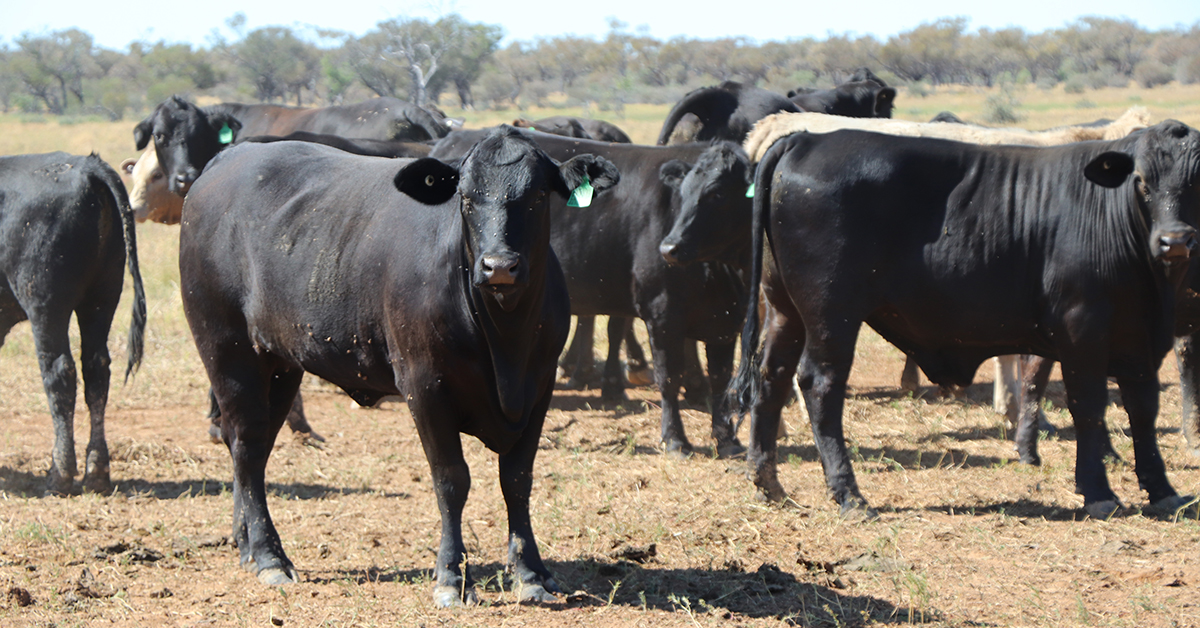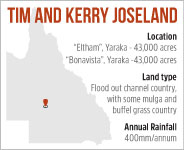Black Cattle on the Barcoo


 On the banks of the Barcoo, just north of Yaraka in Queensland’s channel country, Tim and Kerry Joseland run a breeding operation, producing Angus influenced weaners. Their operation is run on two properties – “Eltham” and “Bonavista” – both 43,000 acres a piece.
On the banks of the Barcoo, just north of Yaraka in Queensland’s channel country, Tim and Kerry Joseland run a breeding operation, producing Angus influenced weaners. Their operation is run on two properties – “Eltham” and “Bonavista” – both 43,000 acres a piece.
The Angus Influence
Originally a Droughtmaster based herd, the Joselands initial foray into Angus came when the opportunity arose to buy a herd of Angus cross breeders locally. From there they started buying Angus bulls, with the aim to produce progeny that they could place in southern markets.
“New South Wales gets that earlier break in spring and that’s where we used to get caught a bit, being our driest time, we realised that we needed an article to sell into the south into the New South Welsh spring,” explains Tim.
In order to increase the Angus content of their herd Tim and Kerry have used both pure bred Angus bulls and Ultrablacks and, despite having successfully used purebred Angus bulls and being pleased with the results, the Joselands value the adaption advantages that come with using Ultrablacks.
“That splash of hardiness in the Ultrablacks is important and works well in our operation. In a dry pinch, which you do get in this country quite often, they can withstand that. With Angus bulls, you need to find them and get them in, that can be difficult, and you have manage them a bit and spend more time on them,” he adds.
Despite this they try to keep the Brahman influence to a minimum.
“There is variation in content in the Ultrablacks, some swing to a bit more Brahman content but we like to swing the other way and get very soft bulls with that splash of hardiness. Feet and walking ability is a big thing,” says Tim.
They have some trouble with pink eye in their herd and treat affected animals with antibiotics.
“We were hoping that Ultrablack would be the answer and they are certainly more resistant, but it is still a major issue. It’s an extra management time and cost, it’s the biggest problem with British bred cattle, especially out here with the dry times we experience and the dust and scratching them on prickly bushes. Because we only bring them in twice a year over the two rounds, it’s a little bit hard to manage,” says Kerry.
Heat tolerance has also been a concern for the Joselands but they feel that, even though the cattle experience high temperatures at “Eltham” there is sufficient shade for them to get out of the heat. In their experience, they adapt and learn to feed at night in the cool.
When selecting bulls, Tim and Kerry look for soft bulls with ‘a bit of leg’ and walking ability and then consider EBVs – particularly milking and calving ease figures.
They feel that the bulls acclimatised really well and really value the temperament of Angus and Ultrablacks and their polledness.
“We have found with most of the stud Angus and Ultrablack bulls, that their temperament has been incredible. Also, no dehorning is an absolutely major advantage, dehorning is just unnecessary stress,” says Tim.
Managing the Droughts and Flooding Rains
Grazing management in Tim and Kerry’s operation is a balance between opportunistic pasture utilisation and spell-grazing. They also identify bigger scale as a major advantage to better manage the feed and country types.
“We are running our stocking rate pretty conservatively and we utilise our land types accordingly. Now that we have more country it’s a lot easier to manage,” he says.
With 20,000 acres of flood out country from the Barcoo and other channel systems and the balance being a mixture of lighter country consisting of mulga, pulled gidgee, melon holes, Mitchell and Flinders grasses and Buffel grass creeks, the Joselands feel that the mixture of land and pasture type is a valuable asset.
“The flood out country from the Barcoo channels is very beneficial. The catchment is in the heavier rainfall area to the East so when we get a lighter season and there is big rain at Blackall, Tambo, Jericho, Barcaldine, we benefit. It is amazing. Some years, like in 2008, we had 7 inches that year and around Blackall had 10-15 inches in a few days, so we got the flood water out of that which gets you through. It floods out 10km wide,” says Kerry.
“It’s the different variety of country that helps us. Having the variety definitely makes this country safer,” adds Tim.
After rain, herbage such as gidgee burr, button grass, carrot weed, pig weed, lambs tongue and blue bush, often very high in protein, is the first to respond and cattle are spread over the property to utilise it.
“You have to manage the herbage, come September to November when it is stinking hot the herbage just shrivels up and then it is gone, you have to utilise it. We spread our stock out and manage it otherwise you waste it,” says Kerry.
In addition to managing the utilisation of the herbage is the management of the feed availability in the channels.
“When there are floods going on we shut our cattle out of the river and give them access to the lighter country. When the river dries, and the flooding risk has dropped we put them back into the heavier channel country, spelling the outside country,” says Tim.
“In the current season where we have had ongoing rain, we haven’t shut them out of the lighter country because they are making use of the herbage, if we shut them out we are wasting that herbage,” he says.
As the season progresses to what is usually the driest time of year (August through to November) the cattle on “Eltham” rely more on top feed such a Mulga and Boree.
“Top feed will get you through for a couple of months until you get enough rain (approximately half an inch) to get a response from the herbage. You need a bit more rain to gain a response on the heavier soil in the river and flood out country,” says Tim.
“It’s incredibly sweet this country, and soft for young cattle. There are some big industry players that have identified that,” he adds.
Breeding for the Season
Having had to destock, source agistment and go droving over a number of years due to poor seasonal conditions, Tim and Kerry stock conservatively, running 800 to 1,000 breeders over the two properties.
Their breeding operation is also heavily influenced by the seasonal conditions.
“We generally join all year round – because the seasons are so erratic in this country you can get caught out, but when the season allows, we pull our bulls out after the first round (March-April) and then have a bit of a gap until it rains (usually just before Christmas),” Tim explains.
“We will wait until we have had 4 inches and then a follow up until we know we have a season to bank on and that it wasn’t a false start before we add the bulls back in,” Tim adds.
“It’s not totally controlled breeding but it allows us to look after our bulls in that time that they are not really needed and check them before they go back in,” he says.
Replacement heifers are initially joined at 18 months old and occasionally younger depending on feed availability and maturity and are selected on similar criteria to that of the bulls; walking ability and softness. Ultimately, the Joselands aim to breed medium framed cows.
“We believe in medium framed cows for this country especially. Big cows take too much to keep full in a drought. Cows with a medium frame will still produce the same quality calf provided that the breeding is there, and they will handle a dry time better, provided you get the calf off. If a big framed cow goes down she takes a lot to get back up again and you won’t run as many, you will run 10-15% more medium framed cows,” says Tim.
All younger breeders and weaners are run at “Eltham” so that they can be more closely managed, while older breeders are run on “Bonavista”.
“We keep the older cows on the southern block, while we generally keep the weaners and maiden heifers in the river and the channels and our younger breeders the on the western side out of the river,” says Tim.
“We do two rounds in a normal season, but will do four in a bad drought, pulling calves off and look after those cows and heifers,” says Kerry.
During the two rounds of mustering the Joselands conduct each year, anything that presents dry is pregtested and if the pregnancy is undetectable they are sold.
The weaner progeny are taken through to light feeder weights of 350-450kg and placed into a variety of markets, including the southern market.
“We do sell them into different markets depending on what seems to be the best at the time. We have sold direct to feedlots, we have sold through AuctionsPlus and we also use the Blackall saleyards which is a very good selling centre,” says Tim.
“It is local knowledge that even if its dry here that our calves and weaners weigh like lead, because they get all that soft herbage like button grass and lamb’s tongue. It’s incredibly good when you have got it for cows, calves and weaners. When it is wall to wall feed weaners just do so well on it, so we are pretty lucky really to have this sweet country that produces such soft feed,” he says.
Written by Jen Peart, Northern Development Officer
Angus Australia acknowledges the funds provided by the Australian Government through the Meat & Livestock Australia Donor Company (MDC).
This resource was created as a result of a collaboration between Angus Australia and Meat & Livestock Australia Donor Company (MDC) (Project P.PSH.1063).